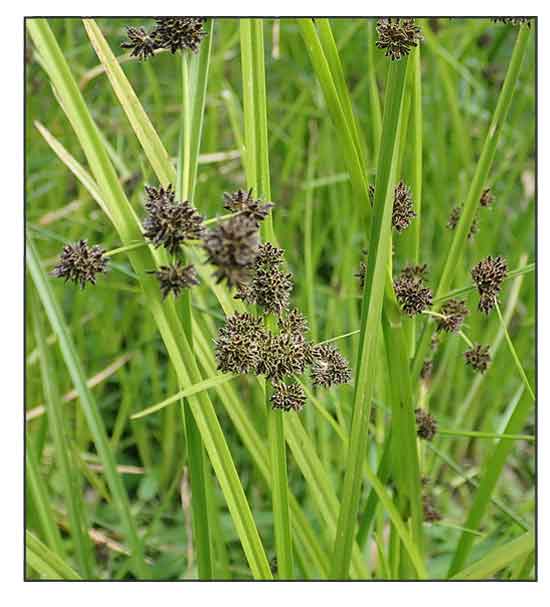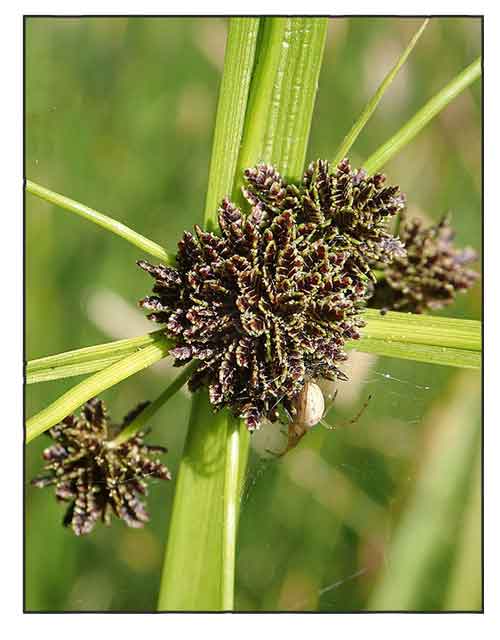
Family • Cyperaceae
Baki-baki
Cyperus difformis L.
SMALL FLOWER UMBRELLA SEDGE / RICE SEDGE
Yi xing suo cao
| Scientific names | Common names |
| Cyperus difformis L. | Baki-baki (Tagalog) |
| Cyperus difformis var. breviglobosus Kük. | Ballayang (Iloko) |
| Cyperus difformis f. humilis Debeaux | Bankoan (Philippines) |
| Cyperus difformis f. maximus C.B.Clarke | Baong-baong (Philippines) |
| Cyperus difformis var. subdecompositus Kük. | Gilhamon (Cebu Bis.) |
| Cyperus goeringii Steud. | Sirau-sirau (Philippines) |
| Cyperus holoschoenoides Jan ex Schult. | Ubod-ubod (Philippines) |
| Cyperus lateriflorus Torr. | Dirty dora (Engl.) |
| Cyperus oryzetorum Steud. | One-arm sedge (Engl.) |
| Cyperus protractus Link | Rice sedge (Engl.) |
| Cyperus subrotunndus Llanos | Small-flowered nut sedge (Engl.) |
| Cyperus viridis Willd. ex Kunth | Small flowered umbrella plant (Engl.) |
| Small flower umbrella-sedge (Engl.) | |
| Variable flatsedge (Engl.) | |
| Cyperus difformis L. is an accepted species. KEW: Plants of the World Online | |
| Other vernacular names |
| ALBANIA: Truska dyformash. |
| BRAZIL: Junquinho. |
| CHINA: Yi xing suo cao. |
| CZECHOSLOVAKIA: Sachorec nepravidelny. |
| FRANCE: Souchet a petites flwurs, Souchet difforme. |
| HINDI: Motha, Dila. |
| HUNGARY: Rizspalka. |
| INDONESIA: Jebungan, Jukut pendul, Ramon brendelan. |
| ITALY: Cipero globoso. |
| JAPAN: Tamagayatsuri. |
| KOREA-DPR: Albang dong sani. |
| MALAYSIA: Rumput air. |
| NEPAL: Chow, Guchen, Mothey, Ochumani. |
| NIGERIA: Imeremere. |
| PORTUGUES: Negrinha. |
| ROMANIA: Panul porcului de balta. |
| SIERRA LEONE: A-kek-a-pot. |
| SPANISH: Cortadera, Estoquillo, Juncia de agua, Ileivun, Tiña, Varita de San Jose. |
| TAIWAN: Chyou-hwa-hau-tsau. |
| THAILAND: Kok ka-narg, Kok khanaak. |
| URDU: Ghoin. |
October 2023
![]()
 |
| PHOTOS / ILLUSTRATIONS |
| IMAGE SOURCE: Cyperus difformis near Narrabri Creek, Narrabri / Margaret R Donald / CC BY-SA 4.0 International / click on image or link to go to source page / image modified / Wikimedia Commons |
| OTHER IMAGE SOURCE: Cyperus difformis near Narrabri Creek, Narrabri / close up of inflorescence / MargaretRDonald / CC BY-SA 4.0 International / click on image or link to go to source page / image modified / Wikipedia |
Additional
Sources and Suggested Readings |
• |
DOI: It is not uncommon for links on studies/sources to change. Copying and pasting the information on the search window or using the DOI (if available) will often redirect to the new link page. (Citing and Using a (DOI) Digital Object Identifier) |
PHOTOS / ILLUSTRATIONS |
| List of Understudied Philippine Medicinal Plants |
| New plant names needed The compilation now numbers over 1,300 medicinal plants. While I believe there are hundreds more that can be added to the collection, they are becoming increasingly difficult to find. If you know of a medicinal plant to suggest for inclusion, please email the info: local plant name (if known), any known folkloric medicinal use, scientific name (most helpful), and, if available, a photo. Suggestions are greatly appreciated. (G.Stuart) |
 |



